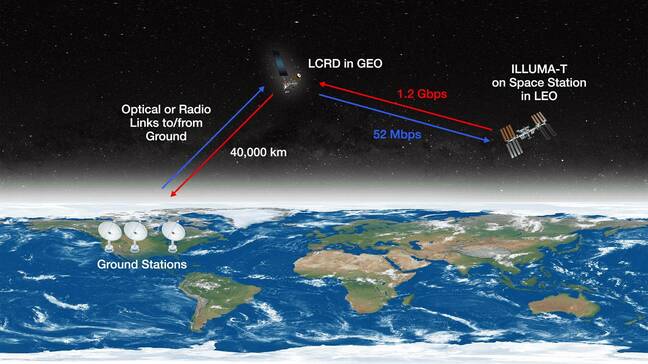NASA to outdo most Americans on internet speeds, gigabit kit heading to the ISS
See hot singles in your area! Well, -453.8 F singles at least
NASA's laser-based, gigabit-speed space internet is set to get its first orbital users just as soon as a new refrigerator-sized piece of hardware makes it to the International Space Station.
The Integrated LCRD Low Earth Orbit User Modem and Amplifier Terminal, or ILLUMA-T, will be relayed to the ISS with SpaceX's 29th Commercial Resupply Services mission, where it'll be strapped to the Japanese Kibo experiment module and delivered into orbit. ILLUMA-T won't send traffic directly to Earth, and will instead use NASA's Laser Communications Relay Demonstration (LCRD) satellite, launched in 2021, to relay traffic to established ground stations in Hawaii and California.
"Once ILLUMA-T is on the space station, the terminal will send high-resolution data, including pictures and videos to LCRD at a rate of 1.2 gigabits-per-second," said Matt Magsamen, deputy project manager for ILLUMA-T. "This demonstration will show how laser communications can benefit missions in low Earth orbit."
While transmission speeds from the ISS to the LCRD are rated at approximately 1.2Gbps, uploads back to the ISS from LCRD will only be a measly 52Mbps. That's still enough to stream a 4K movie from orbit, were astronauts so inclined and NASA generous enough to waste precious bandwidth on such orbital frivolity.
Infrared laser communications offer between 10 and 100 times the speed of radio frequency systems, NASA said, but the space agency doesn't see laser comms as a replacement for radio systems so much as a supplement. While NASA has tested laser communications in the past, ILLUMA-T will be the agency's "first two-way, end-to-end laser relay system."
In addition to being far faster, NASA said that ILLUMA-T and other laser communications systems are smaller, lighter and less power hungry than radio communications equipment, freeing up space both on launch craft and the ISS for more scientific kit.
The system's other component, LCRD, has spent the past two years in orbit testing laser communications by shunting traffic between its Haleakala and Table Mountain base stations with the geosynchronous satellite being used as an intermediary.
- To infinity and beyond, with a swarm of tiny computers costing under $1K each
- NASA to fire 1Gbps laser 'Wi-Fi' ... into spaaaaace
- Uncle Sam wants DEF CON hackers to pwn this Moonlighter satellite in space
- America longs to expand low-Earth orbit economy 'for the benefits of humanity'
"First light, which is when ILLUMA-T makes its first laser signal link with LCRD, is expected to occur roughly two months after launch and installation on the International Space Station," NASA said. "We anticipate an early 2024 timeframe for first light and then we will begin experiment period with LCRD for a total of approximately six months operations."
ILLUMA-T and LCRD aren't NASA's only planned optical data transmission experiments. In May, the TeraByte InfraRed Delivery (TBIRD) system managed to achieve 200Gpbs speeds from orbit to its ground station, and the asteroid-bound Psyche mission set to launch in October will be testing the Deep Space Optical Communication system as well.
Even Artemis II, NASA's first mission to take humans back to the Moon's orbit late next year will feature an optical communication system similarly designed to enable faster transmission of high-definition images and data.
If everything goes according to plan, ILLUMA-T will be delivered to the ISS in the beginning of November, with CRS-29 scheduled for liftoff on November 1. The experimental phase of ILLUMA-T's life will last six months, after which NASA said it will become an operational asset for the space station. ®

